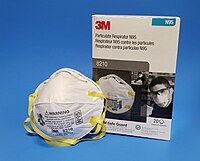
Photo from wikipedia
Objectives To explore the association between N95 respirator wearing and device-related pressure injury (DRPI) and to provide a basis for protecting medical staff from skin injuries. Design A cross-sectional, multicentre… Click to show full abstract
Objectives To explore the association between N95 respirator wearing and device-related pressure injury (DRPI) and to provide a basis for protecting medical staff from skin injuries. Design A cross-sectional, multicentre study. Setting and participants Medical staff of 60 hospitals were selected from 145 designated medical institutions located in the epidemic area where the patients with COVID-19 were treated in China. Results In total, 1761 respondents wore N95 respirators (use alone 20.8%; combination use 79.2%), and the prevalence of DRPI was 59.2% (95% CI 56.93 to 61.53). A daily wearing time of >4 hours (OR 1.62, 95% CI 1.11 to 2.35), wearing a N95 respirator in combination with goggles both with the presence of sweating (OR 13.40, 95% CI 7.34 to 23.16) and without the presence of sweating (OR 0.80, 95% CI 0.56 to 1.14) and wearing only a N95 respirator with the presence of sweating (OR 9.60, 95% CI 7.00 to 13.16) were associated with DRPI. A correspondence analysis indicated that if there was no sweating, regardless of whether the N95 respirator was worn by itself or in combination with goggles, single-site DRPI mainly occurred on the nose bridge, cheek and auricle. If there was sweating present, regardless of whether the N95 was worn by itself or in combination with goggles, multiple DRPI sites occurred more often on the face. Conclusions The prevalence of DRPI among medical staff caused by N95 respirators was very high, which was mainly associated with a longer daily wearing time and interaction with sweating. The nasal bridge, cheeks and auricles were the primary protection locations found.
Journal Title: BMJ Open
Year Published: 2021
Link to full text (if available)
Share on Social Media: Sign Up to like & get
recommendations!